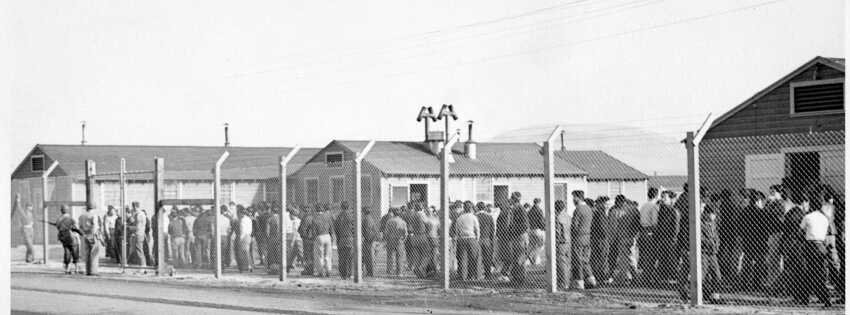
History Being Erased Before Our Eyes: Pushing Back on Attempts to Whitewash U.S. History
At the height of World War II, ACLU NorCal Executive Director Ernest Besig drove 400 miles to Tule Lake, a desolate stretch of high desert surrounded by barbed wire near the Oregon border, to investigate the brutal conditions endured by Japanese Americans incarcerated there under Executive Order 9066. Prisoners had gone on a hunger strike to protest beatings, months of isolation in the stockade, and midnight raids where they were forced to stand in the snow for hours in their underwear and zoris (traditional Japanese sandals made of straw).
Besig had only been at Tule Lake, the largest of the ten wartime incarceration camps, for two days before the director ordered him to leave. On the road home, he discovered that two sacks of salt had been poured into his gas tank.
Yet he would not be deterred from telling the world about the experiences of the Tule Lake prisoners. He wanted to end the injustice and prevent it from ever happening again.
Today, a new executive order is again attempting to silence those voices. Under the Orwellian title of “Restoring Truth and Sanity to American History,” the Trump Administration is ordering the removal of all “inappropriate content” at national parks and sites. The signage, already on display at Manzanar National Historic Site, once an “internment camp” for Japanese Americans from 1942-1945, asks visitors to report “information that is negative about either past or living Americans…”
Richard Potashin, a former interpretive park ranger at Manzanar, explains, “These sites ask us to learn from history not to repeat it. Sadly, never again is now.”
There are many other sites — honoring Emmett Till in Chicago, Stonewall in New York and Cesar Chavez in Delano — that illuminate people’s resistance to oppression. Many exhibits in Northern California are also threatened by the executive order.
One has already been removed. In Marin, William Kent, the donor of Muir Woods and a member of Congress, had long been lauded as a generous philanthropist and author of the legislation that established the National Park system, but his calls for the extension of the Chinese Exclusion Act and his anti-immigrant speeches had not been mentioned in the park. That was rectified a few years ago when the full actions of this complicated man became part of the signage at Muir Woods. This summer, information about his advocacy of racist policies was removed under the new executive order.
Alcatraz, the most visited national park in the country, opened The Big Lockup: Mass Incarceration in the United States in 2021. This unique exhibit examines Alcatraz as a federal penitentiary within the context of incarceration in the U.S., where currently 2.3 million people — disproportionately people of color — are behind bars, more than any other country in the world. The exhibit draws heavily on the pioneering work of Michelle Alexander, former director of the ACLU NorCal Racial Justice Project. Will this be considered “negative” and will it survive the chopping block?
These are just a few examples of the important work of the National Park Service in California that are part of the International Coalition of Sites of Conscience, a global network of historic sites connecting past struggles to today’s movements for human rights and social justice.
Bruce Embry, Chair of the Manzanar Committee, explains that his mother, a U.S. citizen incarcerated there, insisted when she helped craft the legislation to create the Manzanar site that the Commission include the Paiute and Shoshone people so that Manzanar would truly be “a beacon for democracy and justice for all people,” not just Japanese Americans. “The key lesson of these historic sites is that the accurate telling of history requires the guidance of the impacted communities.”
Embry explained that the trauma resulting from Executive Order 9066 lasted for decades and continues to this day. “Many victims did not speak of their experiences. Many stories have been lost, so the efforts of the NPS staff at Manzanar is a tremendous archive that must be protected.”
Barbara Takei of the Tule Lake Committee drew the parallels to today. “The Japanese American community has been feeling fearful and traumatized by current events. We see our nation repeating the hate-filled crimes of WWII — scapegoating immigrants and smearing people of color with racist propaganda and false narratives.”
Both the Tule Lake Committee and Manzanar Committee, along with the National Parks Conservation Association, are pushing back on this attempt to whitewash our nation’s history and silence people’s true experiences by executive order. “Just as it took a thoroughly engaged community to create these sites, it will require a community-wide effort to defend them. We need to create a powerful, nationwide coalition defending all our parks, especially the sites of conscience,” added Embry.
Eighty years after Besig’s visit to Tule Lake, ACLU continues his mission. Executive Director Abdi Soltani said, “These historic sites tell the story of not just an injustice carried out by our government, but also of the resilience of people who stood up and spoke up for constitutional rights.”
